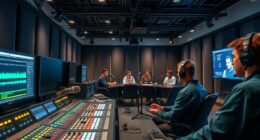Machine learning revolutionizes automatic dialogue replacement by enabling real-time lip synchronization and improving audio quality. It analyzes actor’s lip movements to generate perfectly matched speech, reducing manual editing and post-production time. Advanced models also distinguish speech from background noise, making dialogues clearer even in noisy environments. This technology continually improves with more data and adapts to different accents. If you want to see how these innovations are shaping the future of audio post-production, keep exploring.
Key Takeaways
- Machine learning analyzes actor lip movements in real-time to automatically generate synchronized, natural-sounding dialogue.
- It reduces manual effort by automating lip synchronization and post-production audio adjustments.
- Advanced noise reduction models distinguish speech from background noise, improving audio clarity.
- Continuous learning enhances model accuracy across diverse accents and acoustic environments.
- Integration of NLP tools helps capture dialogue context and tone, elevating ADR quality and production efficiency.

Automatic Dialogue Replacement (ADR) has traditionally been a time-consuming and labor-intensive process in film and television production. You often find yourself spending hours in post-production, trying to match new recordings with on-screen performances. This process involves meticulous lip synchronization, ensuring that the actor’s dialogue aligns perfectly with their lip movements, which can be painstaking and sometimes frustrating. Additionally, noise reduction plays a critical role, as background sounds or unwanted noise in the original recordings can make matching dialogue more difficult. These challenges have historically slowed down workflows and increased production costs.
However, recent advances in machine learning are transforming ADR into a more efficient and accurate task. Modern algorithms analyze the actor’s lip movements and automatically generate audio that matches those movements in real-time. This means you can now achieve precise lip synchronization without manually adjusting every frame, saving you significant time and effort. Machine learning models are trained on vast datasets of speech and facial movements, enabling them to predict and synthesize speech that naturally aligns with the actor’s lip patterns. As a result, you get smoother, more natural-sounding dialogue that seamlessly integrates with the visual performance.
Machine learning enables real-time, precise lip sync, making ADR faster and more natural.
Noise reduction is also greatly enhanced by these technologies. Instead of relying solely on traditional filters or manual editing, machine learning models can intelligently distinguish speech from background noise. They learn to suppress unwanted sounds while preserving the clarity and tone of the dialogue, even in challenging acoustic environments. This means you can work with cleaner audio recordings, reducing the need for extensive manual cleanup and re-recordings. The models adapt to different noise profiles, whether it’s traffic, crowd chatter, or equipment hum, making your post-production process faster and more reliable.
Furthermore, these systems continuously improve as they process more data, becoming better at handling diverse accents, speech patterns, and acoustic conditions. You, as a filmmaker or sound engineer, benefit from this by achieving higher quality ADR with less effort. Instead of spending days fine-tuning audio tracks, you can rely on machine learning to automate much of the work, allowing you to focus on other creative aspects of your project. The integration of these AI-driven tools into existing workflows democratizes high-quality ADR, making professional-sounding audio achievable even with limited resources.
In addition, incorporating natural language processing techniques helps these models better understand context and emotional tone, leading to even more realistic dialogue synthesis. You, as a filmmaker or sound engineer, benefit from this by achieving higher quality ADR with less effort. Instead of spending days fine-tuning audio tracks, you can rely on machine learning to automate much of the work, allowing you to focus on other creative aspects of your project. The integration of these AI-driven tools into existing workflows democratizes high-quality ADR, making professional-sounding audio achievable even with limited resources.
In essence, machine learning is revolutionizing ADR by making lip synchronization more precise and noise reduction more effective. You gain faster turnaround times, improved audio quality, and a more streamlined post-production process. This technology not only saves you time and money but also elevates the overall production value, helping you deliver a polished final product with less hassle.
Frequently Asked Questions
How Does Machine Learning Improve ADR Accuracy?
Machine learning improves ADR accuracy by enhancing voice synchronization and noise reduction. It analyzes original dialogue to better match lip movements and timing, ensuring seamless synchronization. Additionally, it filters out background noise, making the dubbed audio clearer and more natural. You benefit from more precise alignment and cleaner sound, which results in a more believable and professional final product. This technology streamlines the ADR process, saving you time and effort while delivering higher quality results.
What Are Common Challenges in Implementing ML for ADR?
You face challenges like maintaining data privacy and avoiding dataset bias when implementing ML for ADR. Ensuring sensitive data stays protected requires strict security measures, while biased datasets can lead to inaccurate results. You must carefully curate diverse, representative data and follow privacy regulations. Balancing these factors is essential to develop reliable, fair ML models that improve ADR without compromising user trust or quality.
Can Ml-Based ADR Adapt to Different Languages?
Yes, ML-based ADR can adapt to different languages, but it requires robust multilingual adaptation and cross-cultural synchronization. You need diverse training data to guarantee the system accurately captures linguistic nuances and cultural context. By designing models that recognize language-specific features and cultural differences, you improve lip-sync accuracy and emotional expression, making the dialogue feel natural across various languages. This approach helps create more authentic, globally relatable performances.
How Does ML Handle Emotional Nuances in Dialogue?
You can leverage machine learning to handle emotional nuances in dialogue through emotional recognition and sentiment analysis. These techniques analyze vocal tone, pitch, and context to identify emotions accurately. By training models on diverse emotional data, you enable the system to adapt and respond appropriately, ensuring the dialogue sounds natural. This approach helps your ADR process capture subtle emotional cues, enhancing authenticity and viewer engagement.
What Are the Future Trends in Ml-Driven ADR Technology?
You’ll see future ML-driven ADR technology focus on enhancing synthetic voices with emotional analysis, making dialogue sound more authentic. Expect advancements that allow real-time emotional adaptation, capturing subtle nuances and vocal intonations. These trends aim to personalize voice replacements, reducing the need for extensive re-recording. As a result, productions will become more efficient, and viewers will experience more natural, emotionally resonant performances, driven by smarter, more responsive AI systems.
Conclusion
You now see how machine learning acts as a bridge, seamlessly connecting actors’ performances with perfect audio matches. It’s like having a skilled puppeteer behind the scenes, pulling the strings to create flawless dialogue replacements. As technology advances, your ability to craft immersive, realistic audio environments will only grow stronger. Embrace these innovations, because they’re shaping the future of filmmaking—turning once impossible edits into simple, achievable feats. The stage is set for endless creative possibilities.









